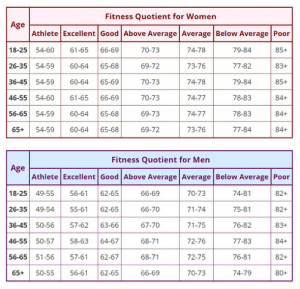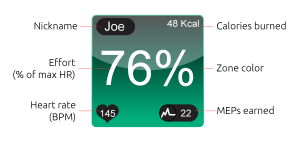Can you tell me how hard you’re actually working in the gym? How about your method for measuring your progress over the past few weeks (or months) of training? And your strategy for using the perfect rest and work periods to reach your goals?No? Well, no wonder you’re not seeing the results you desire …
The truth is tracking sets, reps, rest, and the load is a great start, but measuring your effort unlocks real, objective data you can leverage to ensure your training is actually transforming your body. Monitoring your effort is the secret to optimizing your training, your body, and your results.
And how do we measure effort? It’s not by sweat or sessions per week …
Effort is measured with a heart rate monitor.
Before you bail, assuming you know the truth behind heart rate tracking, hear me out …
You probably don’t know the real, training-changing benefits a heart rate monitor provides, and what it can do for you.
The main feature of heart rate training is that it provides real-time, objective feedback synced right to your phone. But what does that mean? Well, this data allows you to see how hard you are actually working, and how to adjust your approach to maximize your results. You do want every drop of sweat, every heavy breath, and every minute at the gym to pay off, right? So why not optimize everything?
It's time to make smarter, more-effective decisions for your training. Let's look at how a heart rate monitor will change the way you train — for the better.
Recovery-Based Rest Periods Trump Time-Based Rest Periods
The cookie-cutter, 60-second rest periods you’ve been following for decades might be exactly what is holding you back from burning stubborn body fat and replacing it with toned, sexy muscles. With a heart rate monitor, you can base your rest/recovery periods on your unique physiology.
You see, every body is different and everybody is different, so resting for an arbitrary period of time is an old-school way of thinking. Currently, you’re either staring at the clock for too long; giving your body too much time to recover and negating the gains you’re working toward, or you’re resting too little; hitting your next set with less than ideal recovery and sacrificing performance (and results).
With a heart rate monitor, you’ll know exactly when you’re at 60-65% of your Max Heart Rate (no calculations needed) and ready for your next set. This effort-based recovery tells you the perfect moment to stop resting and start working.
Heart Rate Monitor Training Ensures Your HIIT Actually Works
If you are using interval training to develop your anaerobic capacity or power (i.e., your short-term energy system), you need to take enough time to recover in between intervals so you have the ability to put forth another high-intensity effort on your next work interval(s). You also must make sure your version of “high intensity” actually qualifies as “high intensity” by ensuring you’re working at 80-95% of your max heart rate.
A heart rate monitor allows you to manipulate your rest/work periods to elicit the many benefits of high-intensity interval training (HIIT). The fact is far too many people who are using HIIT as their preferred method of training are either not putting forth the 85-100% effort required to experience its most-publicized benefits or they aren’t resting long enough after each work interval to allow themselves to put forth another equally powerful effort. As a result of the latter, it really becomes more of an endurance workout rather than the originally intended high-intensity session.
Without real-time, tangible data, it’s hard to know if your HIIT is effective.
Heart Rate Training Ensures You’re Using The Right Energy System For Your Goals
On the other hand, if you are trying to improve your aerobic power or capacity, a heart rate monitor can make sure you do not push yourself too hard during training. If you do, your body will rely too much on your anaerobic system — pulling you from your goals.
When you spend too much time using your anaerobic system, you start creating metabolic waste, which builds up and can lead to a decline in your ability to maintain a sustained work effort for a decent amount of time.
Simply put, a heart rate monitor can help you maintain the correct training zones to ensure you are working toward accomplishing your desired training effect, AKA your goals.
Tracking Your Resting Heart Rate Is An Objective Way to Measure Long-Term Results
Beyond the in-session implications of heart rate training, a heart rate monitor can also be used to track your morning resting heart rate (RHR). This is the measurement that should be taken when you first wake up each day.
While it sounds simple, its value is tremendous.
Your resting heart rate (RHR) is an excellent indicator of your overall aerobic fitness level, superior to most arbitrary measurements. If you want to see if your body is truly adapting to your training, it is best to take your measurement for a few mornings in a row so you can establish your baseline number. Track it over time and if you see it jump by 10 beats per minute (BPM) or more, it may mean you need some more time to recover from your training, or a light, recovery workout that day. However, if you’re seeing a decrease in BPM, you know your training is truly paying off!
RHR can range anywhere from 40-100 beats per minute (BPM) with anything under 60 BPM being a good indicator of someone who is very fit, aerobically.
Use the chart below to determine your current fitness level based on RHR:

Modern Heart Rate Monitors Are Simple & Affordable
Most people think you have to spend a lot of money to purchase a sophisticated (or overly-complicated) device to track your heart rate ... oh, and from there, you’ll need a calculator and a Ph.D. in Exercise Science to even have a shot at figuring out how the numbers the device spits out are useful to you.
Well, times have changed …
Technology has evolved and the industry has adapted. Simple-to-use monitors with easy-to-understand data are the norm. In fact, for only $40, you can buy a ‘Polar Chest Strap with Transmitter’; download an App like ‘MotiFit’ and you are good to go. Or, for a slightly larger investment, use the industry-favorite MyZone Heart Rate Tracking System which includes an app for more robust, easy-to-digest results, post-workout summaries sent to your inbox, and a bit of gamification. And if you are a serious runner, cyclist, or triathlete, you can go all-in on a sophisticated monitor meant for your specific needs like a Garmin Forerunner with GPS.
The reality is you can get an outstanding, easy-to-use heart rate monitor for less than $100.
My Pick: The MyZone Heart Rate Tracking System
I find the biggest concern with heart rate tracking is the ability to analyze and understand the numbers. If you’re serious about your results, I highly recommend the MyZone System. It’s an easy-to-use, lightweight strap that syncs to your phone with an associated app.

The app’s simple, sleek design spits out the exact percentage of your heart rate you’re currently at and uses color-coded tiles to give you a quick view of your effort (red, of course, is the hardest ). Here’s a snapshot below to show you what I’m talking about:

Bonus points for MyZone’s MEPs score, which measures your average effort and workout duration to give you “points” for immediate feedback on your workout and an ability to earn badges and compete with friends, family, and others who use the system. For those who dread working out, it definitely makes it a little more entertaining. And if you love competition, you can compete with friends and family for MEPs.
The MyZone system is the heart rate monitor I use for all of my workouts. At a total cost of only $100, it’s the best investment for people who consistently train and the one I recommend most often to my clients.
The cost includes your strap and app that spits out the real-time data we’ve discussed, a post-workout summary email after each session, and plenty of other cool features to keep you motivated and in-tune to your results.
You can find the My Zone Heart Rate Tracking System Right HERE
Final Word on Heart Rate Training
As with any piece of fitness equipment, a heart rate monitor is only useful if you learn from it and adapt your training based on the data. Otherwise, you are just recording information for the sake of it. Heart rate monitors will help you ensure your hard work is paying off by tracking your resting heart rate and tweaking your training in real-time to optimize results through rest-based recovery and objective effort.
Long story short, heart rate monitors have the ability to optimize the way you train and ensure real results.
Time is a very precious commodity so why not optimize the time you dedicate to your health by training smarter and more efficiently?
Happy Training!
—Joe



